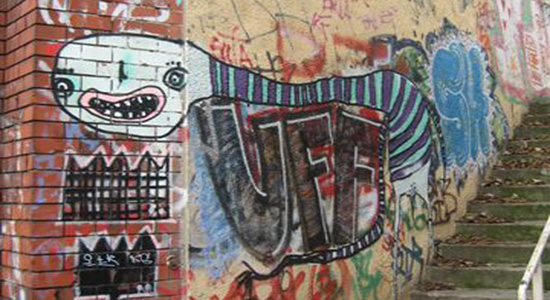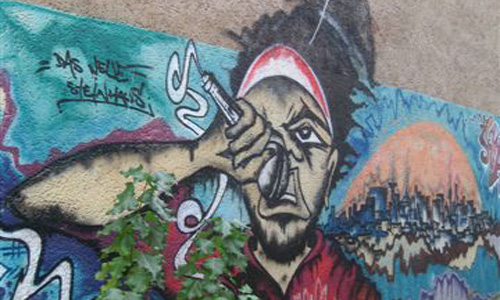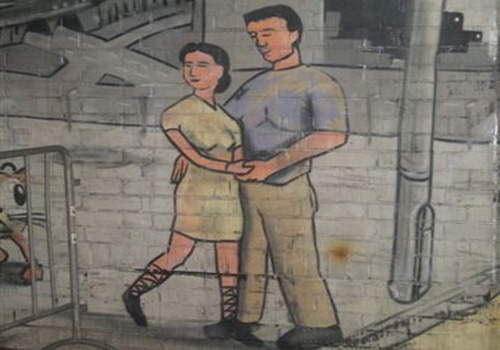HEGEL SPOKEN HERE
Or WHY GERMANS JUST LOVE TO TELL YOU HOW BAD THEY'VE BEEN
by David Kirby
photos by Barbara Hamby

W H A T D O G S S A Y A B O U T T H E I R M A S T E R S
A New York friend was yanked to the ground not long ago by her Cairn terrier Henry and broke her wrist. That wouldn’t happen here in Berlin—well, it might, but it seems less likely, given the exemplary behavior of that city’s canines.
Can a culture really be judged by the comportment of its dogs? On my first day in Germany’s capital city, I noticed how many Berlin dogs don’t require leashes at all and trotted along by their owners’ heels, pausing for a quick sniff or to throw a glance at another dog but never straying. And even among the leashed dogs, I never saw a self-indulgent lurcher like Henry.
German discipline, in its healthy as well as its frightful forms, is legendary. But if you think you’re overestimating that country’s love of order, all you have to do is visit the nuclear fallout shelter under the Story of Berlin Museum. This cold-war facility was designed to house 3,600 citizens for a 14-day stay; the residents were to wear simple uniforms (their contaminated attire would have been left on the surface) and live on bread and water in a reduced-oxygen atmosphere intended to keep them in a state of zombie-like submissiveness. Given a choice, I could see myself turning my back on the city’s rubble and starting the long hike to the French border.
Berliners are a little quick to compare their city to Paris, to say, for example, that the Ku’damm is their version of the Champs-Élysées. But Paris is done: construction goes on down river, and an architect might throw up a glass pyramid in the Louvre courtyard, but the city that Baron Haussmann re-shaped in the mid-nineteenth century doesn’t change much. Berlin, on the other hand, is exciting precisely because it’s in a state of constant change, and if vistas of beautiful old buildings are marred by cranes and open pits, a visitor gets a sense of energy that is not just under but on the surface, preserving and renewing.
And some parts of Berlin are deliberately kept ugly. In this twentieth anniversary year of the fall of the Berlin Wall, one finds huge slabs of it on display in Potsdamer Platz, where tourists line up to have their pictures taken and Berliners themselves chat with actors playing border guards as they practice what they call Ostalgie (a portmanteau word made of ost or east and Nostalgie). Ostalgie becomes downright cute when you see how crazy Berliners are for the stocky little guy in the porkpie hat who is still the crossing-light symbol in the former East Berlin. After the fall of the Wall, authorities wanted to replace him with the standard icon, but former East Berliners launched a successful campaign to keep the Ampelmännchen (“traffic-light man”) a part of their culture.

C O M I N G C L E A N
Ostalgie seems a curiously German phenomenon. This is, after all, the people that came up with Schadenfreude to describe a complicated, interpenetrating feeling one shouldn’t have but does anyway. There is a straightforward tendency to confront the past that is uniquely German; as Nicholas Kulish wrote last year in The New York Times, while other countries celebrate the best in their pasts, “Germany unrelentingly promotes its worst.”
Everywhere, Germany admits it was wrong, as in the powerful, massive Memorial to the Murdered European Jews, a five and a half acre site in the heart of the city consisting of 2,711 sarcophagus-like slabs. And the repenting seems to have no end: the Times article reports on the construction of two new monuments, one to the murdered Gypsies and another to the gays and lesbians killed in the Holocaust. Perhaps because of this tendency toward frankness, one hears phrases like “when the Nazis murdered the Jews” in Germany more than references to “the Holocaust,” the abstraction preferred in the States. (The less-visceral term occurs first in Middle English and derives from Greek holokauston, which merely refers to “burnt sacrifice.”)
This public breast-beating has been in evidence at least since the sixties, when radical students proclaimed themselves the heroes their parents weren’t. Even in the years between Hitler’s suicide and the rise of the Baader-Meinhof gang, Germans weren’t ready to take on the full horror of what they’d done: the 1950 German translation of The Diary of Anne Frank (originally written in Dutch) pointedly omitted all anti-German references.
Perhaps the best way to understand this shift from repression to confession is to consider the difference between two emotional states that seem similar but are actually quite different. June Price Tanguey and Ronda L. Dearing’s Shame and Guilt is the classic book-length treatise on its subject; here the authors point out that, while shame is toxic in nature, guilt is actually a virtue of sorts. “Shame is an extremely painful and ugly feeling that has a negative impact on interpersonal behavior,” say the authors. Shame-prone individuals are more likely to blame others, are more prone to anger and resentment, and are less able to empathize. “Guilt, on the other hand, may not be that bad, after all. Guilt-prone individuals appear better able to empathize with others and to accept responsibility for negative interpersonal events.”
Given that the murder of Jews and others by Nazis is the ultimate “negative interpersonal event,” coming clean seems to be the way to go. Imagine if a country were an individual: as Roy F. Baumeister and others say in “Guilt: An Interpersonal Approach,” an oft-cited essay on the topic, “the ideal relationship partner would presumably be neither the person who is immune to guilt nor the one who is frequently consumed with guilt feelings. Rather, it would . . . be the person who is so sensitive to guilt that he or she carefully and consistently acts in ways that will prevent guilt.” The bottom line is that “guilt may be most beneficial if people alter their actions so as to prevent it from ever actually occurring.”
Which is exactly why post-war Germany has adopted the language of Hegel as its way to explain itself to its “relationship partners.” I took the title of my essay from a New Yorker review Anthony Lane wrote of The Baader Meinhof Complex, a 2008 German movie about the left-wing terrorist group called the Red Army Faction that was better known by the names of two of its leaders, Andreas Baader and Ulrike Meinhof. When one of their colleagues, Gudrun Ensslin, goes on trial, Lane points out how startling it is to see that her parents condemn yet support her, her pastor father talking of Ennslin’s “holy self-realization.”
It is then that Lane says “only Germans still speak fluent Hegelian,” meaning the philosopher’s thesis-antithesis-synthesis explanation for human progress. You begin with an idea (the French Revolution that will eliminate an oppressive monarchy) that is met by its opposite (the bloody war of the revolutionary factions among themselves), and out of this collision comes a new idea (a constitutional government). As what Tanguey and Dearing call a “shame-prone individual,” if I do something bad, you’re not going to hear about it. But today’s Germans don’t have any problem with forthrightness about how much their dads and moms loved to kill.
The Hegelian dialectic that characterizes Germany’s presentation of itself to itself and others is like nothing else among the nations of the world. The quick comparison, of course, is to its neighbor to the south. As Tobias Jones points out in The Dark Heart of Italy, that country was an ally of Germany and then its foe, and individual allegiances led to clashes between Fascist and partisan forces that continue to resonant; until recently, many elected and appointed officials, had been Fascist leaders and made no attempt to hide their past. Other countries have faced their problems, notes Jones, whereas working out what happened in Italy is “like trying to write on water.”
But Germany was arguing against itself long before the postwar period, and Hegelian dialectic dominates not only philosophy and politics but the national literature as well. It even predates Hegel: in 1774, Goethe’s The Sorrows of Young Werther became the first internationally known work of German literature. It’s also the first German epistolary novel, and a letter is a working-out, an ostensible missive to another but really a conversation with the self in which one figures out what one really thinks about love, the purpose of life, and so on. Werther is among the earliest works of Romaticism, itself one long argument pitting heart against head, nature against the city, and classic literary forms against such newer ones as novels like Werther itself.

T H I S W A Y T O T H E C R E M A T O R I U M , F O L K S
Today, the conversation continues. The best-known novel of the postwar era, Günter Grass’s The Tin Drum, covers the years between the twenties and the fifties, and its narrator, Oskar Matzerath, who seems to oppose the emergent Nazi party as well as embody its violence, refers to himself in both the first and the third person, often in the same sentence. Grass himself had some explaining to do when he revealed in 2006 that he had been a member of the Waffen-SS, the combat wing of the Nazi Party. A long-standing critic of Germany's Nazi past, Grass came in for charges of hypocrisy for not making the admission earlier.
True, there are still-visitable concentration camps all over Germany, and Berlin’s is the Sachsenhausen complex, where the visitor will be smothered with details that demonstrate how systematically savage the Nazis were. But there is no greater demonstration of the past’s vileness and the present’s desire to vindicate itself than in the Topographie des Terrors, fittingly located in the city’s very heart. The Topographie is an open-air display on the site where the Gestapo, the SS, and other Third Reich administrative groups had their offices—where, in other words, the murder of the Jews and the persecution of other groups were planned. The original buildings were badly damaged in the war and then demolished and forgotten; only lately has the site been rediscovered and plans made to create a permanent exhibit, scheduled to open next year.
But it seems more fitting to display the texts and photos that document Nazi cruelty in the open air, as they are today, since so much of what the Nazis did was carried out publicly. Far from attempting to hide their actions, the masters of terror boasted of them. Partisans hanging from trees in a public park, Jews made to perform calisthenics on a hot sidewalk, a schoolmaster standing before an approving crowd with a sign around his neck that says “I banned students from saying Heil Hitler”: somebody took photos of all these events, kept and cataloged them.
And now the public is seeing these things again, only with revulsion instead of pleasure. Far from covering up their crimes, the Germans want knowledge of them to endure, to remain as indigestible in the body politic as the Trabant, the plastic-body car that the East Germans produced for nearly 30 years. Thanks to Ostalgie, the “Trabi” is as popular today as the Ampelmännchen, but it’s 100% non-biodegradable. Long after the last cockroach has disappeared, the Trabi will endure.
At the end of his extraordinary memoir Survival in Auschwitz, Primo Levi reminds us that “we are all in the ghetto, that the ghetto is walled in, that outside the ghetto reign the lords of death, and that close by the train is waiting.” The Topographie des Terrors is designed to make us remember precisely this. The guest book in the temporary visitors center contains one entry that reads: “Thanks to the Germans who have the courage to speak of such a sorrow-laden past. This witness permits young generations to not forget that everything can fall apart very quickly when democracy exists no more.” Other entries say simply “Merci,” “Grazie,” “Danke.”
In 1891, Mark Twain called Berlin “the newest city I have ever encountered,” and that seems true today as well. There is so much raw construction underway that it is easy to overlook not only the beautiful old buildings but the contemporary ones as well, such as the stunning Sony Center complex in Potsdamer Platz that gives the city a new heart.
Too, much of Berlin’s beauty is inside, unnoticed. The Gemäldegalerie doesn’t have the cachet of the overcrowded Uffizi, so it’s nearly empty, and one can stand before its Botticellis for hours, one’s view unimpeded by bored school groups or Italian husbands reading La Gazzeta dello Sport. By contrast, the 1,865-seat Deutsche Oper was filled to capacity on a Sunday afternoon for a five hour and fifteen minute performance of Tristan und Isolde.
As Wagner’s lovers sing and die, outside today’s Germans remake their culture with the same love of organization, the same dedication and work ethic their fathers used to send millions to their deaths.
-------------------------------------------------------------------------------
Author's Note: When quoting from books and articles, I have cited their titles and authors in the text. Two additional books provided background information: Jillian Becker’s Hitler’s Children: The Story of the Baader-Meinhof Terrorist Gang and Francine Prose’s Anne Frank: The Book, the Life, the Afterlife. Thanks to John Corrigan and Thomas Joiner for their help with this piece.
Return to table of contents here.
